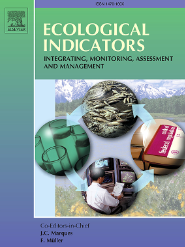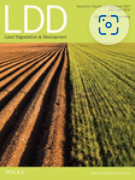
You are here
Publications in Journals
Peer review Papers published in International Journals and Magazines. As publications, we present articles published in peer-review journals indexed in Scopus or Web of Science.
Publications in Journals include more than 390 published papers from the Soil Group in the JRC (EU Soil Observatory). Most of the papers refer to the last 10 years (2013-2023). In many cases the papers document the datasets published in ESDAC.
As example statistics, Since the establishement of the EUSO, the group published:
- 23 papers in 2020,
- 27 papers in 2021
- 40 papers in 2022
- 46 papers in 2023
An important number of papers has been published in high impact factor journals: Nature, Nature Climate Change, Nature Communications, Science Advances, Science, PNAS, Global Change Biology, Science of the Total Environment, etc.
The publications are relevant to soil themes, functions and threats. The datasets generated during and/or analysed during most of the presented studies are available in the ESDAC datasets section. Almost all the publications are Open Access.
You can browse in the publications by year and you can download them (A hyperlink is provided per each publication).
Filters
Go Back To
All Documents

|
The Relevance of Geopedology for Policy Making and Soil Security |
|
|
Resource Type: Maps & Documents, Documents, Publications in Journals |
Year: 2023 |
|
|
|
||
|
|
||

|
Micro-and nanoplastics in soils: Tracing research progression from comprehensive analysis to ecotoxicological effects |
|
|
Resource Type: Documents, Publications in Journals, Maps & Documents |
Year: 2023 |
|
|
|
||
|
|
||

|
Assessing marginality of Camelina (C. sativa L. Crantz) in rotation with barley production in Southern Europe: A modelling approach |
|
|
Resource Type: Documents, Publications in Journals, Maps & Documents |
Year: 2023 |
|
|
|
||
|
|
||

|
Climate and environmental data contribute to the prediction of grain commodity prices using deep learning |
|
|
Resource Type: Maps & Documents, Documents, Publications in Journals |
Year: 2023 |
|
|
|
||
|
|
||

|
Automatic blight disease detection in potato (Solanum tuberosum L.) and tomato (Solanum lycopersicum, L. 1753) plants using deep learning |
|
|
Resource Type: Documents, Publications in Journals, Maps & Documents |
Year: 2023 |
|
|
|
||
|
|
||

|
Fine earth soil bulk density at 0.2 m depth from Land Use and Coverage Area Frame Survey (LUCAS) soil 2018 |
|
|
Resource Type: Maps & Documents, Documents, Publications in Journals |
Year: 2023 |
|
|
|
||
|
|
||

|
Genetic variability of Chamaerops humilis (Arecaceae) throughout its native range highlights two species movement pathways from its area of origin |
|
|
Resource Type: Documents, Publications in Journals, Maps & Documents |
Year: 2023 |
|
|
|
||
|
|
||

|
Short-Term Crop Residue Management in No-Tillage Cultivation Effects on Soil Quality Indicators in Virginia |
|
|
Resource Type: Maps & Documents, Documents, Publications in Journals |
Year: 2023 |
|
|
|
||
|
|
||

|
Digital soil mapping of Italy to map derived soil profiles with neural networks |
|
|
Resource Type: Documents, Publications in Journals, Maps & Documents |
Year: 2023 |
|
|
|
||
|
|
||

|
Soil organic carbon under conservation agriculture in Mediterranean and humid subtropical climates: Global meta‐analysis |
|
|
Resource Type: Maps & Documents, Documents, Publications in Journals |
Year: 2023 |
|
|
|
||
|
|
||

|
What is the extension of bench terrace construction for forest plantations? The case of North Central Portugal |
|
|
Resource Type: Documents, Publications in Journals, Maps & Documents |
Year: 2023 |
|
|
|
||
|
|
||

|
Impacts of barley (Hordeum vulgare L.) straw mulch on post-fire soil erosion and ground vegetation recovery in a strawberry tree (Arbutus unedo L.) stand |
|
|
Resource Type: Documents, Publications in Journals, Maps & Documents |
Year: 2023 |
|
|
|
||
|
|
||

|
Response on the “Characterising wildfire impacts on ecosystem services: A triangulation of scientific findings, governmental reports, and expert perceptions in Portugal” |
|
|
Resource Type: Documents, Publications in Journals, Maps & Documents |
Year: 2023 |
|
|
|
||
|
|
||

|
How much does it cost to mitigate soil erosion after wildfires? |
|
|
Resource Type: Documents, Publications in Journals, Maps & Documents |
Year: 2023 |
|
|
|
||
|
|
||

|
Denitrification Losses in Response to N Fertilizer Rates—Integrating High Temporal Resolution N₂O, In Situ ¹⁵N₂O and ¹⁵N₂ Measurements and Fertilizer ¹⁵N Recoveries in Intensive Sugarcane Systems |
|
|
Resource Type: Maps & Documents, Documents, Publications in Journals |
Year: 2023 |
|
|
|
||
|
|
||

|
Combining nitrification inhibitors with a reduced N rate maintains yield and reduces N₂O emissions in sweet corn |
|
|
Resource Type: Maps & Documents, Documents, Publications in Journals |
Year: 2023 |
|
|
|
||
|
|
||

|
Nonlinear response of N₂O and N₂ emissions to increasing soil nitrate availability in a tropical sugarcane soil |
|
|
Resource Type: Maps & Documents, Documents, Publications in Journals |
Year: 2023 |
|
|
|
||
|
|
||

|
Soil zinc fertilisation does not increase maize yields in 17 out of 19 sites in Sub-Saharan Africa but improves nutritional maize quality in most sites |
|
|
Resource Type: Documents, Publications in Journals, Maps & Documents |
Year: 2023 |
|
|
|
||
|
|
||

|
Disentangling Jenny’s equation by machine learning |
|
|
Resource Type: Documents, Publications in Journals, Maps & Documents |
Year: 2023 |
|
|
|
||
|
|
||

|
Lung cancer mortality and soil content of arsenic and cadmium: an ecological study in 26 EU countries |
|
|
Resource Type: Documents, Publications in Journals, Maps & Documents |
Year: 2023 |
|
|
|
||
|
|
||

|
Evaluation of the United Nations Sustainable Development Goal 15.3.1 indicator of land degradation in the European Union |
|
|
Resource Type: Documents, Publications in Journals, Maps & Documents |
Year: 2023 |
|
|
|
||
|
|
||
|
|
Developing a high-resolution land use/land cover map by upgrading CORINE’s agricultural components using detailed national and pan-European datasets |
|
|
Resource Type: Maps & Documents, Documents, Publications in Journals |
Year: 2022 |
|
|
|
||
|
|
||

|
48-year effect on organic carbon and nitrogen stocks in two soil types in northwestern Tunisia |
|
|
Resource Type: Documents, Publications in Journals, Maps & Documents |
Year: 2022 |
|
|
|
||
|
|
||

|
Computation of total soil organic carbon stock and its standard deviation from layered soils |
|
|
Resource Type: Documents, Publications in Journals, Maps & Documents |
Year: 2022 |
|
|
|
||
|
|
||

|
Improving the phosphorus budget of European agricultural soils |
|
|
Resource Type: Documents, Publications in Journals, Maps & Documents |
Year: 2022 |
|
|
|
||
|
|
||